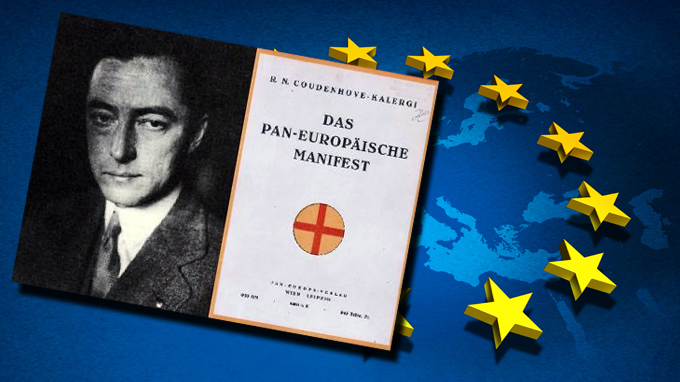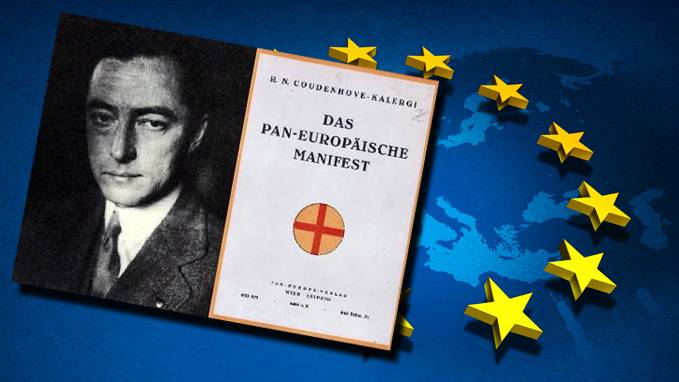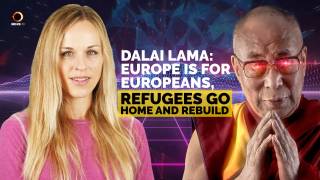Ideological and Geopolitical Origins of the EU, Part I: Richard von Coudenhove-Kalergi's Pan-Europa
Source: eurocanadian.ca

In order to understand the current crisis in Europe created by the cultural Marxist practices and policies of immigration and multiculturalism there is a need to understand the ideological roots of parallel yet intersecting movements. One such movement has been a geopolitical effort, undertaken by various leading statesmen, aimed at creating a pan-European economic order that essentially suppresses ethnic European bonds in favour of cosmopolitan ideals.
Pan-Europa and Eurafrica
Pan-Europa began as an early twentieth century socialist European integration model that was developed by Richard von Coudenhove-Kalergi and based on the ideologies of Cosmopolitanism, Perpetual Peace, and World Federation. Kalergi sought to unite Europe in perpetual peace by replacing ethno-national European identities with a common European cultural identity. This non-ethnic based European Union was envisioned as the first step toward the eventual unification of humanity under a World Federation in perpetual peace.
Kalergi claimed that for the full materialisation of a united and prosperous Europe the joint colonization and exploitation of the resources and land of the African colonies would be required, which would lead to the creation of Eurafrica, a large geopolitical bloc that had the Mediterranean Sea as its central axis and would encompass (and Europeanise) nations in the African and Muslim world south of the Mediterranean. Kalergi's Pan-European project was funded and supported by wealthy bankers, politicians, and cultural forces on both sides of the Atlantic, yet it also met with opposition from authoritarian nationalism in the 1930s and 40s.
The Ideological and Historical Context before World War I
In the 18th and 19th centuries, after constant conflict between European nations, notions of European confederation became increasingly popular among the cultural and political elites on both sides of the Atlantic. The first president of the United States, George Washington (1732-1799), supported the idea of a United States of Europe in a letter to Marquis de LaFayette: "One day, taking its pattern from the United States, there will be founded the United States of Europe". In 1849, at the third International Peace Conference in Paris, a notable French Romantic — the poet, novelist, and dramatist Victor Hugo (1802-1885) — echoed these sentiments, saying that
A day will come when all nations on our continent will form a European brotherhood—.A day will come when we shall see—the United States of America and the United States of Europe face to face, reaching out for each other across the seas.
In mid-18th century a European integration plan based on disarmament and peace titled A Project for Perpetual Peace had been outlined by French philosopher Jean-Jacques Rousseau (1712-1778), who wrote that "[i]t is not possible, therefore, that the confederacy being once established, that any seeds of hostility can remain amongst the confederates"[ii]. His work was based on Abbe de Saint Pierre's Project for a Perpetual Peace (1713), who greatly desired European federation in the context of international peace.
Less than thirty years after the publication of Rousseau's essay, Kant published his essay Idea for a Universal History with a Cosmopolitan Aim (1784), a pretext to his famous essay Toward Perpetual Peace: A Philosophical Sketch (1795). He explained that the conflict of interests, or Hobbesian state of nature, between individuals and nations was what drove human progress and would, through cooperation, mutual recognition, and self-discipline, lead to a future cosmopolitan ideal, a federation of states in perpetual peace. The basis for this peace included the following principles: —The civil constitution of every state should be republican.
—The law of nations shall be founded on a federation of free states.
—The law of world citizenship shall be limited to conditions of universal hospitality.
He also proposed in his Preliminary Articles that disarmament, international arbitration, and the renunciation of colonies would produce perpetual peace.
In the 19th and early 20th centuries peace movements and cosmopolitanism became prevalent in Britain and America. Anti-war organizations sprang up in 1815-1816 and evolved into the London and American Peace Societies, which aimed at gradual disarmament. Cosmopolitanism in early 20th century America went further, focusing on racial equality, liberal immigration, and a universal national identity. Organizations based on anti-discrimination, pro-immigration, and anti-nationalism were established, such as the American Liberal Progressive Movement (1905) and the Immigrant Protective Association (1908).
Several organisations in early 20th century openly supported the notion of a United States of Europe, such as the British Quaker pacifists (1910), the National Peace League (1911), and the European Unity League (1913). Cosmopolitanism drove academic pressure groups to attack "the nationalist canon", such as the British Union of Democratic Control (UDC, 1914). During the interwar period, cosmopolitan books written by the UDC were "derisive of nationalist shibboleths" and could be found in both English and American universities.
Coudenhove-Kalergi and the Pan-European Movement
These anti-national, cosmopolitan, and liberal progressive notions of a peaceful and united Europe soon coalesced into a political project in the interwar era (post WWI) called the Pan-European movement, founded by Count Richard Nikolas Eijiro von Coudenhove-Kalergi in 1922. Kalergi (1894-1972) was an Austro-Hungarian geopolitician and philosopher. His mother, Mitsuko Aoyama, was a wealthy Japanese woman, and his father, Heinrich, was a Bohemian noble from a family of mixed European heritage (Flemish, Czech, Austrian, Hungarian, and Greek) and a long line of nobility (800 year old oligarchical family).
Kalergi wrote numerous books and articles about European integration over his lifetime. His first book was titled Adel, translated as Nobility; this work, along with Pazifismus (1924), was the basis for his Praktischer Idealismus: Adel—Technik—Pazifismus or Practical Idealism: Nobility—Technique—Pacifism (1925). His 1922 article Pan-Europa — A Proposal and his book Pan-Europa (1923) mark the beginning of the Pan European movement, and his monthly journal Paneuropa (1924-1938) and books, The Fight for Paneuropa (1925-1928, three volumes) and Europa Erwacht (Europe Awakened, 1934) among other works, further elaborated his exposition on European integration.
Kalergi established the Pan-European Union (PEU) in 1946 and is often considered the founding father of the European Union. He was the recipient of the first Charlemagne prize in 1950 and today the European Prize Coudenhove-Kalergi is awarded every two years to "leading personalities for their extraordinary commitment in the European unification process". In addition to the Coudenhove-Kalergi Prize, the Europe Square in Austria, a gold Euro coin, an Austrian peace monument and stamp, the European anthem, and a Viennese Park, testify to Kalergi's legacy as a major figurehead in the integration process of Europe. The Pan European Union continues to influence European unity to this day.
The Pan European movement was a political project rooted in notions of peace and international alliance and arose in the interwar era as a response to World War I. At the end of WWI the allied victors set the terms of peace for the defeated powers at the Paris Peace Conference (1919). This conference led to the development of an intergovernmental organisation, the League of Nations (10th January 1920), which was informed by Atlantic world federalism and peace movements. The League aimed at, among other things, peace by disarmament and international arbitration.
However, during the early 1920s and 1930s Europe split into three divisive political ideologies: Liberal Democracy (France and Britain), Communism (Russia, which split from Europe in 1917 signified by the Bolshevik revolution), and authoritarian nationalism (Italy and Germany, fascism).
In this European climate of war, fascism, "nationalistic pretensions", and hostility between Germany and France, Kalergi wrote:
Europe as a political concept does not exist. The part of the world with that name covers peoples and States in chaos, a powder keg of international conflicts, the breeding ground of future conflicts. This is the European Question: the mutual hatred of Europeans for each other poisons the international atmosphere and is a perpetual worry to even the most peace-loving countries of the world... The European Question will be resolved only by the union of the peoples of Europe. This will come about either voluntarily, by the construction of a pan-European federation or coercively by Russian conquest... The greatest obstacle to the realisation of the United States of Europe is the thousand year rivalry between the two most populous nations of Pan-Europe: Germany and France...
Interwar hostilities between France and Germany had a long history (late 1700s) but were greatly inflamed after the defeat of Germany in World War I. France sent colonial troops numbering between 20,000 and 45,000 from Madagascar, West Africa, Morocco, and Algeria to occupy the German Rhineland, a position that was considered by the Germans (and other Europeans) as the "Black horror on the Rhine" as Blacks were considered as "unreliable savages who posed great danger, especially for the German female and juvenile population". The German president, Friedrich Ebert stated that "the deployment of coloured troops of the most inferior culture as overseers of a population of such high spiritual and economic importance as the Rhinelanders is an intolerable violation of the law of European civilization"[vi]. Yet this was just one of the first among many assaults that were to come that targeted German ethnic identity in the Twentieth century.
The Pan-European Union
Kalergi perceived the interwar period as a vital time to prevent another Great War and the destruction of European and Western civilization. He felt that Europe was endangered by European ethnonationalism, particularly Nazism, as well as the "Bolshevik danger", and an American "economic and cultural threat". He thought it was a time of choice between "integration or collapse" and warned against a "future war" that could see American and Soviet powers taking over Europe. He seriously considered that Europe could only become either "the stage of perpetual war or perpetual peace". His remedy for these ills and forebodings was a Pan-European Union (PEU) aimed toward peace.
Pan-Europa would protect and strengthen European economic and political powers at the geopolitical level and enable Europe to once again become a dominant power on par with the others. Europe as a world power related to Kalergi's vision, shared by many of his contemporaries and having roots in the distant past, of a future world federation of humanity. He clarifies the essential aim of the Pan European movement in his Pan-Europa (1923):
if world organisation is to take the place of world anarchy then the first step must be for the states to form themselves into super-states...so the unification of Europe will be a necessary state on the road to a united humanity.
Writing in 1931, he further elaborated this goal: "The great aim—is to make European boundaries invisible" which will lead to European peace and prosperity, conditions that are necessary for the defence of Western civilization and the creation of "the real universal State", a future where "nationalism on a narrow basis" has been replaced by a "patriotism for large areas of the world" and where the "Atlantic brotherhood" has paved the way to "the future federation of humanity".
In order to realise a Pan-European Union and a world federation, Kalergi suggested that the League of Nations be modeled as a "federation of federations" and that the European Union be modeled after the original League of Nations, a "federation of states". This 'federation of federations' was based on the division of the world into five federated geopolitical blocs, or what Kalergi terms "the five great parts of the world — the British Commonwealth, Pan-America, Pan-Europe, Eastern Asia, and the Soviet Union". These five blocs would enable a "balance of power in the world", a necessary arrangement that aimed to "prevent any one part of the world from obtaining hegemony over another".
So the first step towards creating World Federation was the integration of European states into a Pan-European Union (PEU), a federation of states that would represent a third collaborative Atlantic power (on par with Pan-America and the British Commonwealth) acting in concert to "save Western civilization from the great dangers now threatening it".
The Erasure of European Ethno-nationalist Identities
Although European federation was to be based on the collective economic, cultural, militaristic, and political defense of Europe, Kalergi wanted Europe to disarm, to replace militaristic forces with peace forces so it could progress culturally in concord and equality. By "creating a new public opinion, by showing the European a new ideal and common interests" he thought he could create a socially conservative European democracy that united the European peoples and nations. In this vein, he argued that Europe had a shared historical identity that could be renewed:
Historically, culturally and ethically, the unity of Europe was a real unity, temporarily obliterated in later centuries by religious divisions and the conception of linguistic patriotisms. If these narrow patriotisms could be weakened by a common European patriotism, the underlying central conditions of unity would reappear.
This new European patriotism required the cleansing of language-based and ethnic elements of national patriotism that were perceived as not conducive to Kalergi's European peace. For him, "Europe as a cultural unity was—not so much a matter of political, historical, or racial identification, but a matter of morals and of style". Pan-Europeanism would overcome 'egocentric nationalism' based on race and culture[xi]. Indeed, Kalergi envisioned a future of race mixing:
The man of the future will be of mixed race. Today's races and castes will gradually disappear owing to the vanishing of space, time, and prejudice. The Eurasian-Negroid race of the future, similar in its appearance to the Ancient Egyptians, will replace the diversity of peoples with a diversity of individuals.
Kalergi sought to replace individual national ideals of ethnic communities with an ethnically mixed European patriotism, a "common European nationalism" based on a common European culture, "a kind of 'supra-national' nationalism" that is European rather than a balance of powers between the European nations. He wrote that "Europe is one big nation that is divided into branches; racist nationalities see only the branches and think they are trees because, semi-cultured as they are, they are unable to see the trunk". He thought nationalism "is the product of bourgeois semi-culture" and wrote:
Just as aristocrats nourished their self-esteem through the disdain of the bourgeois, so the bourgeois began using the newly discovered nationalism in order to thoroughly despise all other nations. In some way, every nation sees itself as the chosen people, as Grande Nation, as the salt of the earth.
Kalergi rejected "national 'egocentricity'" as "a kind of chauvinist universalism attempting to dominate the others" and thought that ethno-nationalists were "the principal obstacle to his ideas" and "a primary cause of war and human misery"[xv]. To solve cultural-historical national rivalries (particularly those of France and Germany) and attain European integration "existing patriotisms" had to be "sterilised for mischief" while retaining those elements that are "for good". In response to Kalergi's plan, Chairman Mr. Amery suggested that Pan-Europe could help the League of Nations by "separating out purely European causes of friction, thus making the League more truly universal and easier for the United States to join".
This creation of a new Europe, a Pan-Europe, based on new ideals of social democracy rather than feudal aristocracy and a new European identity deprived of its ethnic characteristics, would be overseen, according to Kalergi, by a "social aristocracy of the spirit"[xvii]. He claims that the traits — "[s]trength of character combined with sharpness of spirit" — that are required for the spiritual aristocratic leadership of Europe can be found in the Jewish people alone. These traits, peculiar to the Jewish as a people, "predestine" them "to be leaders of urban humanity, the protagonists of capitalism as well as the revolution." But it is "the Jewish Socialist leaders" who "want to redeem us with the highest self-denial from the original sin of capitalism, free people from injustice, violence and serfdom and change the liberated world into an earthly paradise". Further, he wrote:
[t]he influence of the nobility of blood decreases, the influence of the nobility of spirit is growing. Such a development, and with it the chaos of modern politics, will find its end only when an aristocracy of spirit will seize the reins of society's power: by seizing powder, gold, and printing ink to devote to the welfare of the community.
Eurafrica
Kalergi believed that European federation required using "common resources" so that Europe could develop its "great African territories", which, in turn, would enable Pan-Europe to become "capable of living for itself". It was only through a joint colonization of Africa, rather than national colonial projects, that Europe could fully develop its economic and political potential and prosperity and sustainability 'for all' could be realised.
In 1929, Kalergi coined the term 'Eurafrica'. According to the German philosopher Thorsten Botz-Bornstein, Eurafrica was "an extended version of Europe supposed to include also the European colonies" except for the British colonies, such that "Europe stretches from Angola to Spitzbergen" and the Mediterranean would be "Europe's axis and not its border". In this scheme, Eurafrica was "the multilateral relationship between six European states and their dependencies overseas". It was "purely imperialistic" as it suggested that "millions of Europeans" should settle in the African colonies because "the fatherland had become too narrow", too over-populated, and land and resources were needed. It also proposed that "the colonies would become the main providers of raw materials for the empire", resources that would include hydroelectric power and agricultural produce.
The African colonies would also be 'Europeanized' along with other "regions should they enter the Pan-European Community (like Turkey, Iran, and Afghanistan)" as this would be necessary "for the coherence of Europe as a geopolitical and cultural body". In Europa Erwacht (1934) Kalergi thought that "the Arab population of Africa" will eventually "adopt the European way of life". Although Kalergi thought it necessary for Europe to exploit Africa, he did not intend large-scale immigration and settlement in Europe by African peoples: "Europe must at all costs prevent 'that great numbers of black workers and soldiers immigrate to Europe'".
The supranational Pan-Europe and Eurafrica project represented the birth of a third geopolitical power that would create a balance of powers in the world. In 1931 all colonial powers except for Britain were invited to the Colonial Exposition in Paris to display their colonial possessions. This was to be followed by European cooperation in the African colonies themselves.
Funding, Support, Leadership, and Opposition
The Pan-European movement and Union were directly funded by powerful financiers and aristocrats. In 1924 Kalergi's friend Baron Louis Nathaniel de Rothschild introduced him to Hamburg banker Max Warburg who offered 60,000 gold marks to fund the first three years of the movement; Warburg and Kalergi remained in "constant intellectual dialogue" thereon. Max introduced him to his brothers Felix and Paul Warburg and the American financier, Bernard Baruch in 1925. Robert Bosch, a German industrialist, "[w]as so impressed by Coudenhove that he set up the Pan-Europe Development Fund". And according to American author David J. Peterson the movement was also "provided financial support and promoted" by the "Thurn und Taxis, Wittlesbachs, Hapsburgs and Kalergi families"[xxv].
Kalergi had the support of many important statesmen, political figureheads, and cultural elites in Britain and Europe. Three years after he founded the Pan European movement he brought thousands of leading European elites together at the First Pan-European Congress (Vienna, 1926). By the mid-Twentieth century, Winston Churchill, Paul-Henri Spaak, Konrad Adenauer, Leon Blum, and Alcide de Gasperi were perceived as the Pan European Union's "five Presidents of Honour".
Austrian Chancellor Ignaz Seipel provided the Pan-Europa movement with headquarters in Hofburg Palace and was President of the PEU Austrian branch, support followed from Chancellors Engelbert Dollfu— and Kurt Schuschnigg, President of Austria, Karl Renner, and Otto von Habsburg, Archduke Otto of Austria. In France endorsement came from Louis Loucheur, who became president of the movement in France in 1927, and from Prime Ministers Leon Blum (Socialist), Eduard Herriot (Radical), Charles de Gaulle, and Aristide Briand, the latter of which spoke in favour of a federal Europe in his speech at the League of Nations (September 1929), and in his Memorandum on the Organisation of a Regime of European Federal Union (1930).
In Germany, foreign minister and Noble Prize laureate Gustav Stresemann, German socialist and President of the Reichstag, Paul Lobe, and numerous pacifists, novelists, and socialists, such as Kurt Hiller, and Heinrich and Thomas Mann, agreed to the Union. The PEU was also endorsed by many other prominent authors, playwrights, poets, and novelists, such as Paul Valery, Gerhart Hauptmann, Rainer Maria Rilke, Stefan Zweig, Franz Werfel, and Arthur Schnitzler, and scientists, such as Albert Einstein and Sigmund Freud.
Opposition to Pan-Europa was prevalent among the fascist nationalists of Italy and the National Socialists of Germany in the 1920s and 30s. Kalergi approached Benito Mussolini twice, in May 1933 and 1936, in an attempt to sway him to the movement, but Mussolini was more interested in discussing fascism in Europe. In Germany, Adolf Hitler called Kalergi a "cosmopolitan bastard" and a right wing 1930s university professor, Ewald Gei—ler, complained that the idea of a Pan-Europe was not new but "always shows its face when France is very near to its highest political goal: Rule over Europe". In return, Kalergi showed his disdain for Hitler by saying "I do not believe anything good or noble can come from such a vulgar physiognomy".
Meanwhile, other anti-fascists before and during the Second World War saw Germany as a problem and published works calling for the "sterilisation" and "outbreeding" of the German race so to rid Europe of the German ethno-national identity manifested in National Socialism, which was perceived as an obstacle to the cosmopolitan plan for European integration. This was a conflict between the political ideologies of cosmopolitanism and political nationalism; between liberal democracy and European ethnonationalism.
Conclusion of Part I
Kalergi's socialist, cosmopolitan, and anti-nationalist European integration model of Pan-Europa, which centered on the Mediterranean as a central axis for geographical unification with African and Arab countries, laid down the groundwork for the development of another, yet similar, integration model in the second half of the Twentieth century. Such a model, known infamously as "Eurabia" and associated with the Euro-Arab Dialogue of the early 1970s, effectively opened European borders to large-scale immigration from the Third World, especially from Muslim lands (Africa, the Middle East, and Asia) and has promoted the culture, language, and religion of Islam as being foundational and on par with European civilization. This European integration model of Eurabia will be examined in Part II.
For the full list of references to this story go to the source at: eurocanadian.ca






















